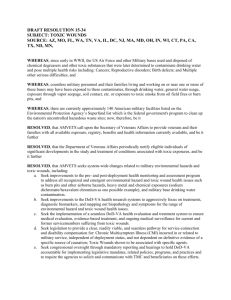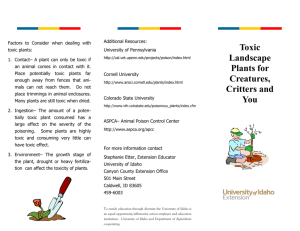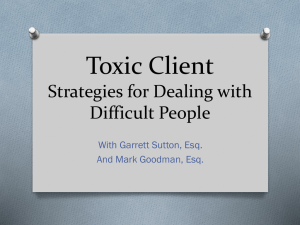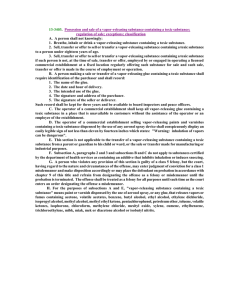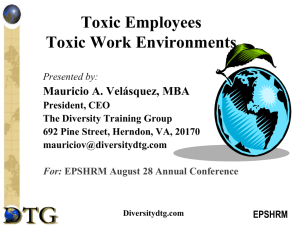Presented - Prince William SHRM Inc.
advertisement
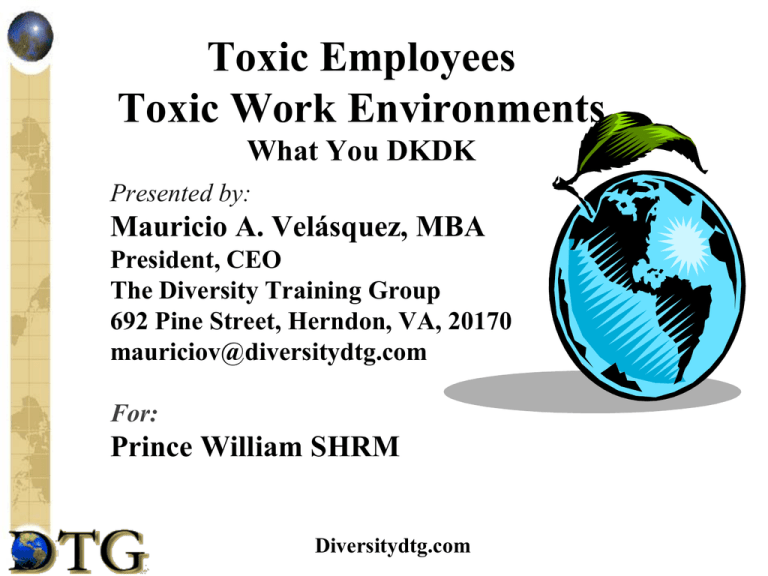
Toxic Employees Toxic Work Environments What You DKDK Presented by: Mauricio A. Velásquez, MBA President, CEO The Diversity Training Group 692 Pine Street, Herndon, VA, 20170 mauriciov@diversitydtg.com For: Prince William SHRM Diversitydtg.com Meet Mauricio Velásquez Mauricio Velásquez is the President and CEO of The Diversity Training Group (DTG) in Herndon, VA. Mauricio serves as a diversity strategy consultant, diversity trainer, sexual harassment prevention trainer, executive coach, mentoring and trust/engagement trainer, and expert witness. DTG’s clients include small and large organizations, public and private entities. Our newest clients thanks to you – Manassas City Public Schools, Manassas City Government, and Spotsylvania County Government. Other new clients – Goodwill of Central Va, Supreme Court, and the USPS. Mauricio has trained nearly a million participants in every state but North Dakota and his life and work have taken him to more than 70 countries in his 25-year career. Mauricio holds a BA from UVA and an MBA from GWU. Diversitydtg.com About Toxic Employees, Environments What You Don’t Know You Don’t Know (DKDK) What You Don’t Know (DK) What You Know (K) We all mean well but… Intent (What you meant to say) MEAN TO SAY/DO vs. Impact (What you actually said) ACTIONS/RESULTS How did I come up with this topic? I have specialized in “hostile audiences” during my twenty years as a trainer and change agent As a Sexual Harassment Prevention Trainer As a Diversity Trainer and Expert Witness Most recently as an Executive Coach where I am asked “…Please meet with him/her 1:1 all day, coach this person (do what you do in your workshop with one of our people) and tell us whether we fire or keep him/her!” Why is this topic so popular? Why is this topic so popular? In The News - Everyday Shootings everywhere – Toxicity gone wild Congress, politics, Middle East Bad economy (insecurity, ambiguity) Economic times make employers and employees do crazy things They have always been this way – no surprise, no change – “accept me” People “don’t say anything” Toxic person is the “last to know” – who me? “People allowed to be awful” – most important – organization knew My Favorite Toxic Participants “I will take anybody but that guy Mauricio” “I don’t give a flying (blank) what this is about, I am not interested!” My “Alaskan Moment of Truth” “You can’t train all of us, some of us you will have to kill!” “You must be a *%$#$ Jew!” (my favorite emails) Agenda Today Understand the toxic employee Understand the toxic work environment Learn how to deal with toxic employees and toxic work environments Relationship between Toxicity, Engagement and High Performance Build a tool kit/skill kit and plan of action Mauricio’s Mission • • • • • • Provoke Thought Facilitate Discussion and Learning Surprise You/Entertain You - Edutain Add Value Provide Subject Matter Expertise Make it interactive and “harness talent in this room” • #1 Ground Rule: PARTICIPATE - Ask Questions!!! Toxic Employee • When you hear the phrase - “toxic employee” what pops into your head? • “Toxic Workplace” – what pops into your head? Toxic Employee • Always unhappy and negative but they don’t keep their misery to themselves. • Why? Because misery loves company! • Body language tells it all • Glass is always half empty • Incredible memory – remembers stuff from years ago • Love to say “Not my job!” • Recruit people to “join them, share their views” • Always “looking for proof” – long memory TE is always looking “for proof” Stereotypes: All of us must begin to address and minimize the many stereotypes that exist within our organization. HOW WE BUILD STEREOTYPES R T E S O E S Y E Group/Categorize/Label T P Form opinion (judge); always negative Look for “proof” Examples: “See, I told you so.” “You’re not like the rest of them.” “You’re the exception to the rule.” HOW WE BREAK DOWN STEREOTYPES Does the comment hold true for everyone in the group? T S T R E E O S Y P E Does the comment reflect knowledge, skills, or abilities necessary to complete the job? Is the person thought of as part of a group first rather than as an individual? Do your past experiences with members of this person’s group affect the interaction? Toxic Employee (Continued) • Can also be bigoted – negativity is projected towards a particular group – gender, race, age, sexual orientation, religion, management or new management • Can be a bully – big, loud, angry (back of my mind – potential for violence in the workplace) • Always recruiting!.... Always approach new hires – “Let me tell you who to watch out for! You with me?” – “Get that smile of your face – don’t you know where you work? Slow it down. You are making the rest of us look bad!” (Encourage mediocrity!) • Ultimate risk – sabotage, violence TE “Poisons” the work environment • First – we all know who they are! • But what do we do about them? – Send them to individual 1:1 coaching or – Train everyone – “dip everybody” and sometimes the TE does not even show up – Or do nothing until something happens – what I call a “moment of truth” – Too many organizations contact us with a reactionary posture or “a real sense of urgency” – Don’t wait – sometimes it is too late – Ignoring these issues/this person – does not mean they go away! The Perfect Toxic Storm • Toxic employee or manager is a bully (well known) • They have a false sense of security – they have never been challenged • How does TE interpret silence of peers? • Peers are avoiders of conflict or they expect “Manager to do something!” BUT – Manager is not skilled to deal with TE – Could be a “Reluctant Manager” – Manager is the smartest and promoted for their technical expertise but they don’t have the interpersonal/human relations skills = DKDK and they MEAN WELL What does all of this toxicity have in common? What DTG keeps coming across.. Massive Conflict Avoidance! No cost-benefit analysis – cost of doing nothing was not calculated If we deny the issues exist If we look the other way – these issues go away by themselves or If we look the other way – these issues will just “work themselves out” Total break down in trust They don’t go away, they fester, they escalate! Do we trust toxic individuals? What is trust? What does it look like? Trust Defined “Trust means confidence. The opposite of trust is suspicion. When you trust people, you have confidence in them – in their integrity, and in their abilities. When you distrust people, you are suspicious of them – of their integrity, their agenda, their capabilities or their track record.” S.M.R. Covey Toxic Individuals are often suspicious and spread suspicion throughout their ranks and create and nurture and welcome long time unresolved conflict because it “maintains the toxicity.” Trust & Conflict – Go Hand in Hand Stephen M. R. Covey – in his book: The Speed of Trust talks about Trust - Taxes and Dividends When there is high trust – there is an actual dividend for this trust – tasks, work, progress, cooperation, collaboration success is easier When there is low or nonexistent trust – there is an actual tax – tasks, work, is harder, indifference, bogged down, sabotage I highly recommend you read this book for your employer, for your kids, for your families and jobs, of course! Economics of Trust Quality of Task High Trust Organization Low Trust Organization Cost of Task Toxic Employee create conflict When you hear this word - what “pops” into your head? What is most common? What happens all too often? What is the cost, price, rest of team pays? Diversitydtg.com Definition of Conflict To come into opposition; to collide or to differ. Conflict occurs when two or more parties believe that what each wants is incompatible with what the other wants. What challenges all of us is we think conflict is negative – yes, but… What if your view of conflict is neutral - negative or positive. (conflict is a constant, an opportunity) HOW CONFLICT IS MANAGED IS WHAT MAKES THE DIFFERENCE! How Conflict is Managed – What Counts What are the positive What are the potential outcomes of conflict negative outcomes if if it is managed well? conflict isn’t managed well? We know it is there, but we We deal with it right ignore it away We will not let the conflict escalate Hoping it goes away by itself When Conflict is Managed Well Experience, research shows….. Creativity inspired Produce a better end result Generate commitment and buy-in Provide a variety of alternatives Misunderstandings are reduced People know what is expected of them Information is shared Information is clear Trust is built When Conflict is Not Managed Experience and research shows…. Frustration Tension Confusion Decreased productivity Increased misunderstandings People do not know what is expected of them and tasks may not be completed according to expectation Reduce trust Toxicity and Engagement Toxic Environments Healthy Environments Demotivating Disengagement is norm Active disengagement is encouraged Allow unresolved conflict to fester Low performing Lo to nonexistent trust Can never be “World Class” Motivating Engagement is norm Active engagement is role modeled Identify and address conflict High performing Hi trust Can become “World Class” To Be World Class…. Respect and Value Each Other Do not be toxic Confront Conflict, Build Trusting Relationships Address toxicity Be More Engaged Perform at Higher Level and we will all be happier, healthier S.M.R. Covey says…. “The ability to establish, grow, extend, and restore trust with all stakeholders – customers/clients, business partners, coworkers – is the key leadership competency of the new global economy.” “Leadership is getting results in a way that inspires trust.” “Toxic individuals, toxic workplaces kill employee engagement, lower morale and crush productivity!” - MV 3 Levels of Engagement ENGAGED (leading, doing, inspiring others, +) NOT ENGAGED (checked out, indifferent, slightly toxic - ) ACTIVELY DISENGAGED (highly toxic, very -) Think of your organization… What percentage of your employees are engaged ( ), not engaged ( ), actively disengaged ( )? Employee Engagement Is Influenced by Toxicity Source: Gallup Consulting So how do we create a more… Effective Respectful Trusting Highly Engaged …work environment and workplace culture? Or, a less Toxic Workplace? Engaging Your Employees – Building Trust, Addressing Toxicity 1) Find out what motivates your direct reports 2) Hire and keep people who are good at their work 3) Get people working on what’s important 4) Explain and train 5) Let people work 6) Be generous with praise and show it 7) Expect excellence 8) Care about people and show it 9) Treat employees with respect 10) Lead by example 11) Build around your mission and core values and hold all accountable Does this improve engagement? From Supervisors/Managers/Leaders in my recent travels… o “You should just be happy you have a job” o “When I want your opinion I will give it to you!” o “You don’t get it – I am management, you are not!” o “When you have been here 20 years – then you can speak.” o “You must be new here, we don’t do it that way here.” Themes: Highly disrespectful, degrading, belittling, demeaning Hostile, angry, threatening If speaking “across difference” potentially illegal Pro status quo, anti-change Organization knew they were bullies and did nothing Trust Commitment Contract (Anti-toxicity) 1) I will make an effort to find out what motivates each of my direct reports. 2) I will give employees frequent, positive feedback and appreciate constructive criticism. 3) I will take the time to listen carefully to people’s ideas, stories, opinions and concerns. 4) I will show support for our goals and objectives and explain them to my staff. 5) I will show support and enthusiasm for my subordinates. SIGN_________________ (share) Trust Commitment Contract continued 6) I will recognize the signs of stress and overload in myself and in the people I manage. 7) I will encourage people to come up with new ideas and ways to approach a project. 8) I will offer everyone on my team opportunities to learn and grow at work. 9) I will promote a diversity of values, opinions, and work styles and believe these are essential to business and work success. 10) I will speak up and hold all accountable. SIGN_______________ (share) Now for Specific Tools I want to give you, build you a tool kit, a skill kit These tools work if you use them! It is up to you – to use them!! Approach is Key PERSON SEPARATE BEHAVIOR Start-Stop Coaching Tip Start with a Positive Please stop_______________________________________ (describe negative/unproductive behavior) Start_____________________________________________ (describe new, more appropriate/positive behavior) Continue_________________________________________ (describe ongoing positive behavior) End with a Positive I- Message Coaching Statement (Start with a Positive) When you ___________________, I feel ______________________ (describe behavior) (impact of behavior) I would prefer ___________________________________________ (new behavior – more appropriate/productive) OR I feel _____________________, when you ____________________ (impact of behavior) (describe behavior) I would prefer ___________________________________________ (new behavior – more appropriate/productive) OR When I see ______________, it makes me feel ____________________ (describe behavior) (impact of behavior on you/group) I would prefer _______________________________________________ (new behavior – more appropriate, more productive) (End with a Positive) A Short Course in Human Relations The Seven Most Important Words: “HOW CAN WE WORK TOGETHER MORE EFFECTIVELY?” The Six Most Important Words: “I ADMIT I MADE A MISTAKE” The Five Most Important Words: “YOU DID A GOOD JOB” The Four Most Important Words: “WHAT IS YOUR OPINION?” A Short Course in Human Relations (cont.) The Three Most Important Words: “IF YOU PLEASE” The Two Most Important Words: “THANK YOU” Or “I’M SORRY” The One Most Important Word: “WE” The Least Important Word: “I” Addressing Conflict – Builds Trust Conflict is just a problem to be solved Step ? Action Example Identify and agree on the problem (consensus) Ask the right questions. Ask for the facts Verify the information Decide what else you need to know “Help me understand exactly” “Let me make sure this is recorded correctly” “I will be able to help you better if I know…” Conduct problemcause analysis to identify a specific problem and its cause Restate the problem in simple terms Get agreement on the problem and its importance/impact “So, the basic issue is…” “It seems we agree it is important to fix this because…” Identify solutions/alternatives Ask what can be done to solve the problem Suggest other options for consideration Tell them what you can do “What ideas do you have on how this can be fixed?” “In similar situations we have..” “I really wish we could do exactly what you suggested. However, according to…, we must…” Steps of Problem-Solving Step Action Example Implement solutions/take action with the help of the customer Ask for their cooperation Tell them what you will do Suggest how they can help, now and the next time “I’ll need your help to…” “Here is what I can do…” “To get this resolved quickly, I’ll need you to…, and if this should happen again, please…” End with an agreement and a thank you. Monitor and follow up on the situation Summarize what will be done, and by whom Thank the customer for cooperation and help Promise to follow up to ensure the solution really worked “Can I assume that we agree on…?” “Thank you for being so cooperative in helping us to solve this problem.” “I will call you in a week to be sure the situation is resolved.” Favorite Quotes "Folks are usually about as happy as they make their minds up to be.” - Abraham Lincoln “You cannot talk yourself out of what you behaved your way into.” - Stephen Covey In Closing…. Ultimately it comes down to this one point SHARED RESPONSIBILITY – we all have a shared responsibility, a responsibility to each other, to hold each other accountable and to be the best we can be. Say to each other - “I can’t be successful without you. We are all in this together!” Action Plan • How can I create a more productive and less toxic work environment? • How can I use what I have learned in this class in my organization and beyond? THANK YOU! FOR…….. YOUR TIME YOUR CONSIDERATION and your PARTICIPATION For more information… CONTACT: The Diversity Training Group 692 Pine Street Herndon, VA 20170 Tel. 703.478.9191 Cell 703.850.1145 Fax 703.709.0591 Mauriciov@diversitydtg.com Mauricio Velásquez, MBA – President, CEO Our Approach FORM a partnership with our client DIAGNOSE with a thorough, organization- wide needs analysis DESIGN a customized program based on a diversity and inclusion strategy DEVELOP high impact training and training materials and support activity IMPLEMENT or execute the strategy which typically includes training, coaching EVALUATE and follow up DTG is a Team of Experts in... Diversity in the Workplace Age Diversity Diversity Marketing, Supplier Diversity Harassment Prevention Assessment / Diagnosis Executive Coaching, Mentoring Ethics, Values (Core Values) Trust Building / Toxic Employee DTG is a Team of Experts in... Stress Management / Bullying / Anger Management Organizational Redesign Cross-Cultural Communication Cultural Intelligence Conflict Resolution & Mediation Sexual Harassment E-Learning Diversity Education E-Learning … consulting & training.



